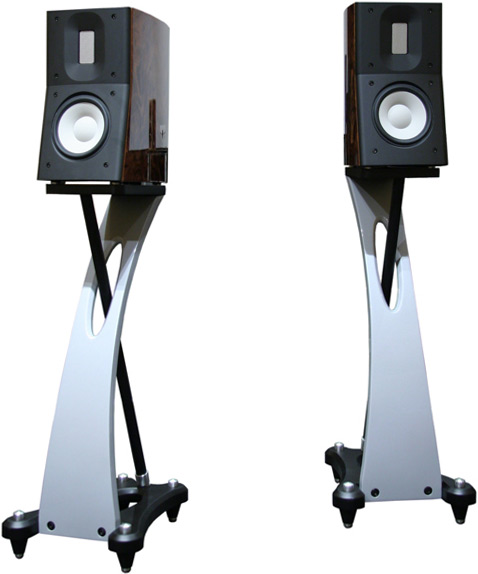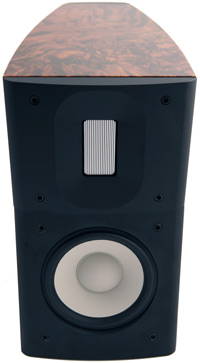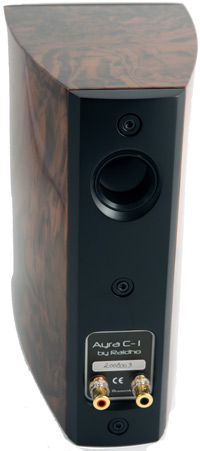And now there are five… there had been four entries in the Flight of the Mini-monitors series. By the way Constantine, how many minis does it take to make a flight? With wine it’s usually between 3 and 5, but can be up to 50. Well, if they keep sounding as good as these I hope you can find 50.
Well, enough of that foolishness, the first speaker in the flight was Teresonic’s Magus, beautiful speakers that used a single Lowther DX55 driver. Second came the beautiful GamuT L3s with their 1.5 inch ring, radiator tweeter. Third, I received the bargain of the bunch, the Genesis 7.1p Petites, and lastly the very musical Bowers & Wilkins 805S speakers. Of the three 2-ways, the GamuTs had an ever-so-slightly more refined sound than the B&Ws, and the B&Ws were also slightly more refined than the Genesis. None of the 2-ways had quite the coherency or sheer life possessed by the Lowther-based Teresonic Magus. All four of the mini-monitors, when placed out in the room, were able to create a holographic soundstage.
There are some audiophiles who lump all mini-monitors into one group and feel they all have the same faults and strengths. They will tell you they do all the audiophile stuff well, but they can never sound like real music, because they lack scale, dynamic range, and deep bass. Heck, I’ve said the first two, but let’s be honest: Very, very few speakers, and even fewer from those with a crossover ever come close to sounding real.
All mini-monitors are not created equal and you just can’t lump them into one group and stereotype the whole lot. In this ongoing survey of mini-monitors, I have honestly been pleasantly surprised by how wonderful they all sounded. Still, so far I haven’t found one for use in my main system to replace a pair of the Audio Note Es, Ikonoklast Model 3HOs, or Teresonic Ingeniums Silvers. Now, I have a brand new one to consider, and I’ll tell you right off the bat: it changes the whole ball game.
The Raidho Ayra C1.0, at $16,100 the pair with stands, surely should compete downstairs with the big boys. To be honest, I had never heard of Raidho before Constantine called me about reviewing them, but I did know the importer, Brian Ackerman of Aaudio Imports. I knew the kind of ear he had for music and how particular he was about details, so I was excited to get this opportunity. So, let’s give them a look and listen.
Description
The Raidho Ayras are beautiful speakers. They have beautiful and impeccable cabinet work. My pair was made of burl walnut with many, many coats of lacquer. If you like that look of shiny, deep-lacquered wood, then I would say they were the most beautiful of the mini-monitors I have reviewed so far. At least that’s true from the side or back; the same beautiful walnut was not used on the front panel. The front panels were plain black. This was necessary to achieve the impeccable sound they have, because they used 20mm thick aluminum for the front panel. They built the drivers right into the two-piece, aluminum front baffle. Still, it kept them from being quite as beautiful far away from the listening chair as the GamuTs or the Teresonics. One look from the side or top though, and the beauty shines through.
As you would expect from a speaker at this price point, the Raidhos used the very finest components to be found. They used hand built drivers which were made in house. I’ve never seen or heard a ribbon tweeter like theirs, in fact this unique tweeter was the component that kick started the company. They’re wonderful, and to my knowledge, uniquely sealed ribbon tweeter employed an array of neodymium magnets to create an extremely powerful force field. It was in this field that the ultra thin membrane was suspended. The membrane weighed less than 0.02 grams, and due to low mass, the tweeter should store no energy nor had any resonances of its own. I found the performance to be unlike and superior to any sealed box ribbon I have ever heard. When a company has done this kind of research on its drivers, and when a speaker is at this price point, you should expect everything else to be made of the very finest materials; you will not be disappointed!
Raidho Acoustics’ design goal was to develop the ultimate drivers for loudspeakers. Their research led them away from the soft and damped drivers so common in many of the modern high-end speakers. They felt the ultimate cone driver would be a ridged piston; a key issue in making piston type drivers is to move the resonant peak out of the area where you are using the driver. Raidho did this by utilizing harder driver materials, a composite of aluminum oxide and aluminum. Their composition is incredibly thin; it is only two skin layers of 150 micron aluminum oxide separated by 100 micron aluminum. It takes more than 60 hours just to create the 150 micron layer. This driver is known as the Raidho Ceramix Driver.
- (Page 1 of 4)
- Next page →




Why don’t you have prices in any of your reviews?
Lindy,
Thank you for your email and readership. We are backfilling the MSRP information into Reviews as we speak because of the Jan 1, 2013 relaunch. Thank you for your patience.
I had B&W 805 and 805s, before them I had Gamut Phi3 (small series), and Gamt Phi3 use to play better than B&W 805s, now I have Gamut M’Inent M3 and trust me, I have sold my B&W 805s because they are really not in the same class, and to notice that I’ve owned Gamut L3 as well, still better than B&W…Sorry mate but I have to disappoint you, we don’t like same things in music, which is why everyone else desides better himself, at the spot…live listening.